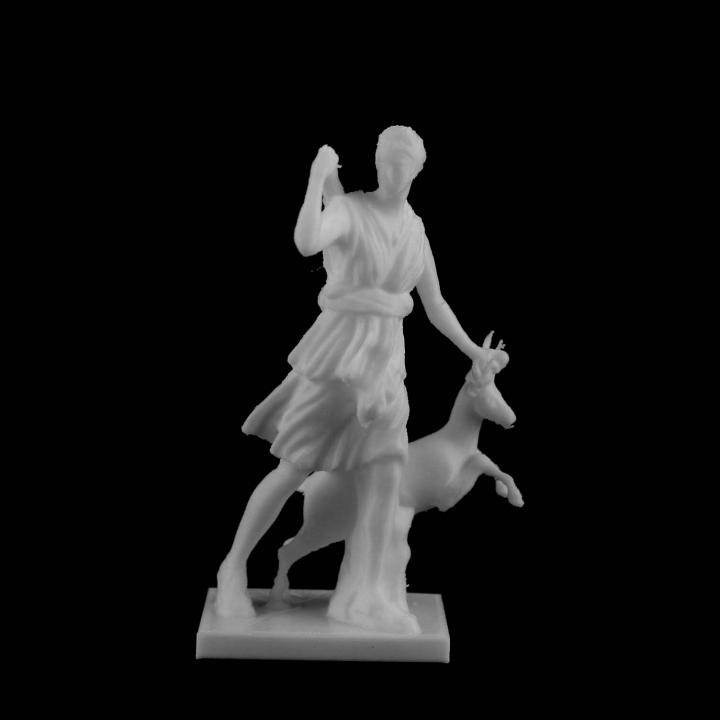
Diana of Versailles at the Jardin des Tuileries, Paris
myminifactory
The Versailles Diana is a larger-than-life marble statue of Greek goddess Artemis, accompanied by a deer, located in the Musée du Louvre, Paris. It's a Roman replica (1st or 2nd century AD) of a lost Greek bronze original attributed to Leochares, circa 325 BC. The statue is also known as Diana with Deer, Huntress Diane, Artemis of the Chase, and Artemis with the Hind. The statue was discovered in Italy: the Louvre website suggests Nemi, where there was an ancient sanctuary; other sources propose Hadrian's Villa at Tivoli; in 1556 it was given by Pope Paul IV to Henry II of France, with a subtle but unmistakable allusion to the king's mistress, Diane de Poitiers. It was installed as the central feature of the Queen's Garden laid out west of the Gallery of Stags at Fontainebleau; there it was the most prominently displayed and among the first Roman sculptures to be seen in France. "Alone amongst the statues exported from Italy before the second half of the seventeenth century, the Huntress Diana acquired a reputation outside Italy equivalent to the masterpieces in the Belvedere or the Villa Borghese," although its admirers generally confused it with the Artemis of Ephesus. In 1602 Henri IV removed it to the Palais du Louvre, where the Diana was installed in a specially designed gallery to receive it, the Hall of Antiques (now the Hall of Caryatids). At the time its restorations were revised by Barthélemy Prieur. Replacing it at Fontainebleau was Prieur's bronze replica cast from it in 1605 (Haskell and Penny 1981:196), which was set upon a high Mannerist marble pedestal arranged by the hydraulic engineer Tommaso Francini, with bronze hunting dogs and stag's heads spitting water by Pierre Briard, 1603, in a parterre surrounded by an orangery. Another full-size bronze replica was made in 1634 by Hubert Le Sueur for Charles I of England, the brother-in-law of Louis XIII. The Diana was installed in the Grande Gallery of Versailles by Louis XIV. For Marly a marble copy was executed by Guillaume Coustou in 1710. As one of France's greatest treasures, the Huntress Diane returned to the Louvre in An VI of the First Republic (1798). It was restored once more, in 1802, by Bernard Lange. Diana is depicted as a slender and masculine huntress, accompanied by a smaller than life buck (male deer) full of life. She looks towards the right, perhaps towards the very deer, as with raised right arm she draws an arrow from the quiver. Her left hand can be seen to be holding the part of a bow, the remainder missing, in position for striking; the missing bow transforming the image into a simple pastoral one from one symbolic of huntress and prey. She wears a short Dorian chiton, a himation around her waist, and sandals. Comparable Roman replicas of the same model, noted by the Louvre's website, have been found at Leptis Magna (Libya) and at Antalya (Turkey). A miniature replica of the statue stood on the fireplace mantle in the Titanic's first class lounge. In 1986, Robert Ballard discovered and photographed the statue on the sea floor near the bow section of the wreck. This object is part of "Scan The World". Scan the World is a non-profit initiative introduced by MyMiniFactory, through which we are creating a digital archive of fully 3D printable sculptures, artworks and landmarks from across the globe for the public to access for free. Scan the World is an open source, community effort, if you have interesting items around you and would like to contribute, email stw@myminifactory.com to find out how you can help.
With this file you will be able to print Diana of Versailles at the Jardin des Tuileries, Paris with your 3D printer. Click on the button and save the file on your computer to work, edit or customize your design. You can also find more 3D designs for printers on Diana of Versailles at the Jardin des Tuileries, Paris.
